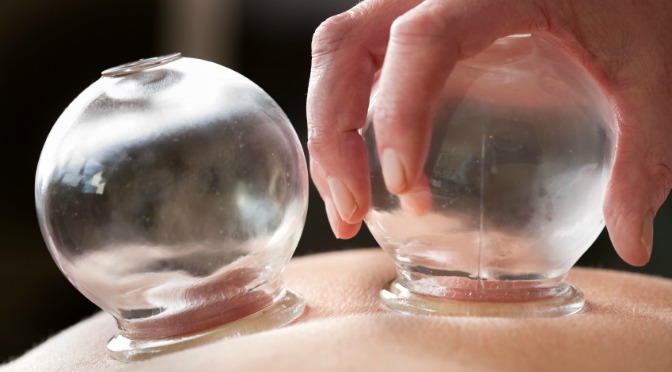During the Summer Olympics, a day didn’t go by without someone asking about Cupping: the alternative therapy that Michael Phelps made (in)famous. The most common questions have been: What is it? Should I try it? Does it work? Does it hurt? What is it good for? WHY would anyone endure those ugly bruises?
Critics point to the absence of clinical studies as proof that cupping is a fad with no effective purpose, and supporters argue that it relieves pain, fatigue and all sorts of illnesses. So, I thought it would be helpful to share how I use this modality, and what my clients here in Pittsburgh have to say about it.
This technique begins with attaching special cups onto the skin. Many types of cups exist, but I stick to plastic and silicone. A hand pump extracts air from plastic cups, and with silicone cups, you simply squeeze it to create suction. From there, the cups can be left on the skin for a few minutes, or pulled across the skin and moved in different ways. The vacuum causes blood vessels in the skin to expand and draw in blood. This new blood saturates the tissue and draws out stagnant blood. At the same time, biochemical that stimulate healing are dispatched to the area.
Cupping is often described as a “reverse massage” since the tissue is being pulled up and away from the body, rather than pressed down. Pain is personal to each individual. Generally, cupping pain is short-lived and mild, and the experience tends to be pleasant and soothing. Sometimes the tissue is very tight and it hurts, but suction can be decreased to modify the pain. As for the marks, well…the longer the cups sit on the body, the more likely marks are to appear. In my practice, I discuss the “hickey” issue ahead of time with my client. If the marks bother them, the cups can be pulled across the skin, which usually doesn’t leave a mark at all, and still has a great therapeutic effect.
Cupping can be used all over the body. In my practice, I apply cups most often to the back neck, shoulders and legs to relieve muscular pain, stimulate relaxation, improve range of motion, and release tight, knotted muscles. I also cup around knees, elbows, ankles and feet to stimulate better circulation and break up scar tissue and adhesions. Most interesting is the use of tiny cups around the head and face; in that regard, my clients have reported relief from headaches and sinus congestion, as well as reduced facial puffiness and improved skin tone, texture and appearance.
Here are some of the comments my clients have made about cupping therapy:
“Cupping sounded like a silly gimmick to me, but Anita has never steered me wrong so I gave it a try. I still can’t believe the relief the cups brought to my chronically inflamed sinuses!” – Misty
“Anita used the cupping technique on my lower back and she had me feeling like a professional athlete! I’ll be back in two weeks for another treatment” – Sam
“I’ve had shoulder and neck pain with frequent headaches. I was a little hesitant on cupping therapy, but after a treatment I feel less pain, headache relief, and more energy in my everyday activities.” – Dennis
“Anita’s cupping therapy is awesome. After my treatment I can move around so much more. I also had cupping on my face and chin area and my skin was noticeably firmer and softer afterwards” – Amy
Interested in learning more and experiencing cupping therapy for yourself?
Contact me to schedule your appointment!

Leave a Reply